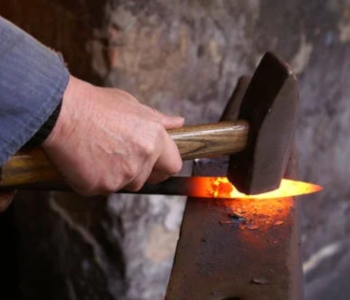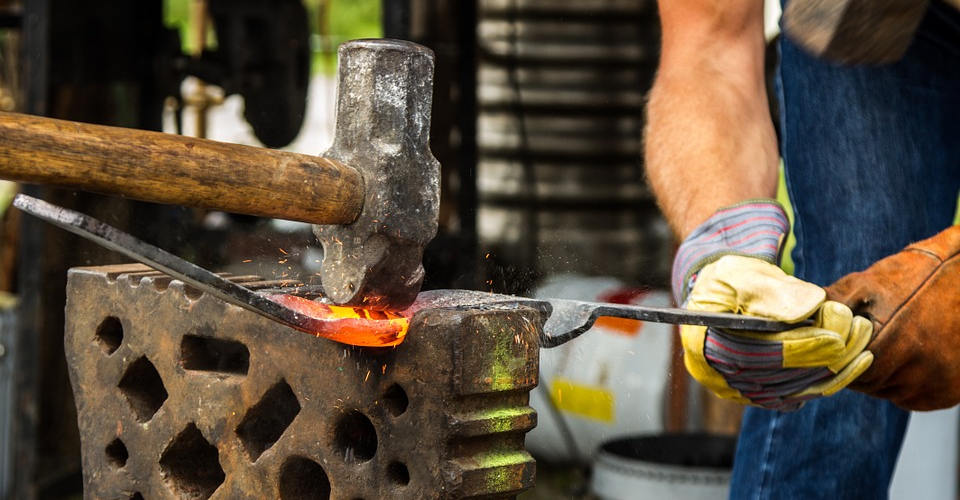What is a Drop Hammer?
The list of tools used in manufacturing is just about as long as the list of the different manufacturing processes. From investment casting to 3D printing, manufacturing processes have been developed and evolved over the decades in response to growing customer and industrial demands.
Despite the years of evolution, some of the tools and techniques have stood the test of time. A drop hammer is one such tool that has been around for a long time yet remains relevant and useful today. What exactly is a drop hammer and how is it used?
Drop forging – the process that uses drop hammers
For us to easily understand what a drop hammer is, we should start by defining the process of drop forging. More generally speaking, forging is a type of forming process where compressive forces are applied to metals to deform them into the desired shape. The visual representation of forging where a blacksmith hammers a piece of metal into a sword or piece of armor is probably familiar to us all.
Thankfully, modern forging processes no longer rely on some burly blacksmith delivering hammer strikes to metal workpieces. Instead, drop hammers are used in the modern equivalent of this decades-old manufacturing method.
Drop forging is unique in that it applies the compressive force needed to deform the metal using a single, quick stroke. This sudden high energy transfer can be powered by gravity alone or facilitated by forces deliver via electricity, hydraulics, or pneumatics. This puts it in contrast with press forging, which achieves the same results by applying compressive forces in a more sustained and extended manner.

The drop hammer is the primary tool used in drop forging. It consists of two main parts – a stationary anvil and a moving ram. For a metal to be deformed to the desired shape, a die made of a hardened piece of steel has to be prepared beforehand and divided into top and bottom pieces. The anvil, located at the bottom of the assembly, contains the lower half of the die while the upper half is attached to the moving ram.
Drop forging can be done on either a cold or heated piece of metal. Heating the workpiece enhances its ductility, allowing for it to be deformed using reduced stress. Working on a piece of cold metal, while faster as it skips the heating step, requires the application of more powerful compressive forces. Some metals are inherently too hard to be processed using cold forging.
In any case, the workpiece is placed inside the lower die. The ram of the drop hammer is then rapidly dropped onto the anvil, resulting in the workpiece getting deformed to the shape of the die. The ram can simply be dropped by gravity or be forced by a column of hydraulic or pneumatic fluids.
This process can be repeated until the results are up to quality standards. In well-established forging processes, the number of blows that a drop hammer must make for each piece is typically already determined and programmed into the forging equipment.
What are the advantages of drop forging?
There is an inherent beauty to the simplicity of the drop forging process. The sudden application of a large stress practically beats the metal into submission, forcing it to take the shape as dictated by the die. Simply put, it’s one of the best manufacturing processes for mass production. This quick application of compressive forces has a couple of benefits:
Fast
Compared to other forming processes, drop forging is one of the fastest. Even if the metal parts need to be heated before being processed, the drop forging step itself typically only takes a few seconds. This makes drop forging one of the most suitable forming options for high-volume production of metal parts. The simplicity of the process also lends itself well to mechanization and easy automation.
Creates strong parts
The compressive forces applied during drop forging results in two strength-improving phenomena. The first is the increase in density of the metal due to compression resulting in the removal of void spaces. The second is the alignment of the metal grain structure along with the potential stress locations.
Forged parts are significantly stronger than parts made by casting or machining. Some heavy-duty metal parts, such as levers and crankshafts for industrial machines, even come with a “drop forged” label as a means of distinguishing them as high-strength materials.
Creates precisely shaped parts
The use of a die to shape the metal parts in forging, as well as the absence of a need to melt the metal, results in parts made with high precision. This may not be a one-step process, as significant post-processing may be necessary. However, the quality of parts made with drop forging is relatively high considering the moderate level of skill needed that the technique demands.
What are its limitations?
The main limitations of the drop forging process are the consequences of its lack of flexibility. Not only is a drop hammer difficult to set up, but the equipment is virtually permanent once it has been established.
Difficult to set up
Central to the quality of results of drop forging is the quality of the die. Since it is made of hard metal, it typically needs to be machined by a highly skilled metal worker. It must also be checked and maintained regularly to keep the quality of forged parts high. This can be a very time-consuming step which significantly extends the time to set up a drop forging process.
Parts may require post-processing
Excess material is often a problem in drop forging. There is no practical way to remove excess metal once the workpiece has already been placed in the drop hammer. Instead, the excess material will have to be trimmed off in post-processing to achieve the desired shape and dimensions of the finished workpiece. This will significantly slow down the manufacturing process if it becomes a recurring event.
Applications of drop forging
As we’ve mentioned, drop forging is such a highly recognized manufacturing process for high-strength parts that they are typically labeled as ‘drop forged’ as a distinguishing mark. As such, you will find drop forged parts in a lot of heavy industries. The automotive industry is probably the largest user of forged materials, although they are also commonly found in airplanes, bikes, railways, and ships.
In large machine assemblies, the gears, levers, and crankshafts are typically made via drop forging. Other common examples include hand tools such as wrenches, hammers, and spanners. Drop forging can also be used to create tools and parts for other manufacturing processes like the mandrels used in a shear forming machine.
Final thoughts
The drop forging process may seem like a deceptively simple manufacturing technique but it’s actually one of the most widely used. Its reliance on simple handling and principles has made it one of the longest-lasting manufacturing techniques.
The drop hammer is the central piece of the drop forging process. Through the sudden application of large compressive forces on a metal workpiece, the metal is deformed in the shape of the preformed die. It’s quick, uncomplicated, and very reliable. Although there’s a significant amount of work and time needed to set up a drop hammer, it’s usually worth the faster throughput once the process is up and running.

